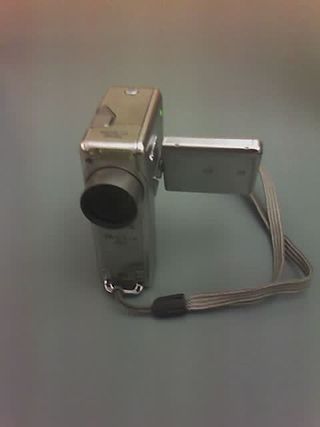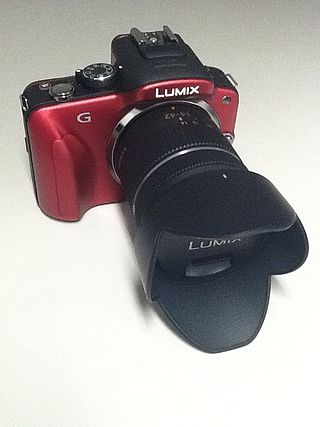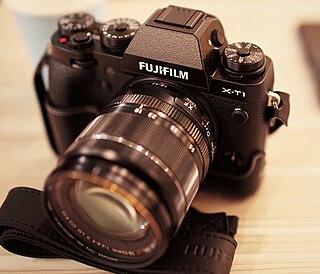
Konica Minolta, Inc. is a Japanese multinational technology company headquartered in Marunouchi, Chiyoda, Tokyo, with offices in 49 countries worldwide. The company manufactures business and industrial imaging products, including copiers, laser printers, multi-functional peripherals (MFPs) and digital print systems for the production printing market. Konica Minolta's Managed Print Service (MPS) is called Optimised Print Services. The company also makes optical devices, including lenses and LCD film; medical and graphic imaging products, such as X-ray image processing systems, colour proofing systems, and X-ray film; photometers, 3-D digitizers, and other sensing products; and textile printers. It once had camera and photo operations inherited from Konica and Minolta but they were sold in 2006 to Sony, with Sony's Alpha series being the successor SLR division brand.

The Digital IXUS is a series of digital cameras released by Canon. It is a line of ultracompact cameras, originally based on the design of Canon's IXUS/IXY/ELPH line of APS cameras.
In photography, shutter lag is the delay between triggering the shutter and when the photograph is actually recorded. This is a common problem in the photography of fast-moving objects or animals and people in motion. The term narrowly refers only to shutter effects, but more broadly refers to all lag between when the shutter button is pressed and when the photo is taken, including metering and focus lag.

The Nikon D1 is a digital single-lens reflex camera (DSLR) made by Nikon Corporation introduced on June 15, 1999. It featured a 2.7-megapixel image sensor, 4.5-frames-per-second continuous shooting, and accepted the full range of Nikon F-mount lenses. The camera body strongly resembled the F5 and had the same general layout of controls, allowing users of Nikon film SLR cameras to quickly become proficient in using the camera. Autofocus speed on the D1 series bodies is extremely fast, even with "screw-driven" AF lenses.

The EasyShare P880 is a bridge digital camera from Kodak introduced on August 2, 2005, as part of Performance series. Its siblings are the P850 and the P712. The P880 possesses the largest optical sensor of all three models, with a size of 1/1.8 inches. Distinguishing features include wide-angle coverage of 24 mm, an on screen histogram display, and manual focus-by-wire. In terms of the Kodak product line and price the Performance series are the most sophisticated EasyShare cameras, just below the considerably more expensive Kodak professional DCS pro SLR digital cameras that were discontinued in May 2005.
The Canon PowerShot S is a series of digital cameras released by Canon, as part of the wider PowerShot range. The S-series was originally a line of compact point-and-shoot cameras, slowly evolving into a prosumer line of cameras slotting right beneath the G-series cameras. The line later branched off into Canon's line of super-zoom cameras. The PowerShot ELPH line is a branch of the S-series, due to its model number designations in the United States, as well as the similarities between the PowerShot ELPH S100 and the PowerShot S10

The Olympus C-740UZ is a digital camera manufactured by Olympus. It was first released in 2003.
The Panasonic Lumix DMC-FZ7 is a six megapixel superzoom bridge digital camera that utilizes Panasonic's Venus II Engine. It features a 12× zoom lens and several modes of operation. It was replaced in 2007 by the DMC-FZ8

The Nikon D300 is a 12.3-megapixel semi-professional DX format digital single-lens reflex camera that Nikon Corporation announced on 23 August 2007 along with the Nikon D3 FX format camera. The D300 was discontinued by Nikon on September 11, 2009, being replaced by the modified Nikon D300S, which was released July 30, 2009. The D300S remained the premier Nikon DX camera until the D7100 was released in early 2013.

The Lumix DMC-L10 is Panasonic's second digital single-lens reflex camera (DSLR), a follow-up to the previous Lumix DMC-L1 model. It was announced in August 2007, and, like the Lumix DMC-L1, this model uses the Four Thirds System lens mount standard and contains some basic parts provided by Olympus.

The Canon PowerShot TX1 is a Canon digital camera. It was released on February 22, 2007 The TX1 is a hybrid device designed for both still imagery and video recording. It offers both HDTV movie capture, as well as 10× stabilized zoom and 7.1 megapixel sensor. It is designed to improve upon hybrid offerings by competitors such as the Sony Cyber-shot M1, Sony Cyber-shot M2, and Pentax MX4. It is oriented vertically and uses the camcorder-like swivel LCD viewing screen. Canon compares the hybrid camera's size to that of the Canon ELPH series of cameras. The company distinguishes the camera for its optical image stabilizer technology, DIGIC III image processor, face detection technology and red-eye effect correction with a mention of its built-in lens cover and scratch-resistant, anti-reflective LCD screen.

A mirrorless camera is a photo camera featuring a single, removable lens and a digital display. The camera does not have a reflex mirror or optical viewfinder like a digital single-lens reflex (DSLR) camera, but may have an electronic viewfinder. Many mirrorless cameras retain a mechanical shutter. Like a DSLR, a mirrorless camera accepts any of a series of interchangeable lenses compatible with its lens mount.

The Panasonic Lumix DMC-G3 is a digital mirrorless interchangeable lens camera adhering to the joint Olympus and Panasonic Micro Four Thirds System (MFT) system design standard. The Panasonic Lumix DMC-G3 is the eighth Panasonic MFT camera introduced under the standard and the thirteenth model MFT camera introduced by either Olympus or Panasonic, as of the G3 product announcement date.

Pentax K-01 is a mirrorless interchangeable-lens camera announced in February 2012. It uses the Pentax K mount.

The Fujifilm X series is a line of digital cameras produced by Fujifilm. The series encompasses fixed lens and interchangeable lens mirrorless cameras and premium compact point-and-shoot cameras aimed at consumer, enthusiast and professional photographers. The X series is part of the larger FinePix range of digital cameras from Fujifilm.

The Fujifilm X-Pro1 is a mirrorless interchangeable-lens digital camera announced in January 2012 and launched in March 2012. It is part of Fujifilm's X-Series of cameras. In October 2012 Fujifilm released a very similar, yet smaller, camera named the X-E1. In January 2016 Fujifilm announced its successor, the X-Pro2.
The Nikon Coolpix S800c is the first digital compact camera with Android operating system announced Aug 22, 2012.

The Sony α7, α7R, α7S and α7C are four closely related families of full-frame mirrorless interchangeable-lens cameras. The first two were announced in October 2013, the third in April 2014 and the fourth in September 2020. They are Sony's first full-frame mirrorless interchangeable lens cameras and share the E-mount with the company's smaller sensor NEX series.

The Sony α6000 is a digital camera announced 12 February 2014. It is a mirrorless interchangeable lens camera (MILC), which has a smaller body form factor than a traditional DSLR while retaining the sensor size and features of an APS-C-sized model. It is targeted at professionals, experienced users, and enthusiasts. It replaced the NEX-6 and NEX-7. Review websites note that although the α6000 uses a 24 MP sensor like the Sony NEX-7, the Sony α6000 can also be seen as more of a replacement of the Sony NEX-6. In the Firmware version 1.10, an android subsystem was added. The sub system was used to run Sony's apps.

The Fujifilm X-T1 is a weather-resistant mirrorless interchangeable lens camera announced by Fujifilm on January 28, 2014. It uses the Fujifilm X-mount and is the first entry in the X-T lineage of DSLR-styled X series cameras.















